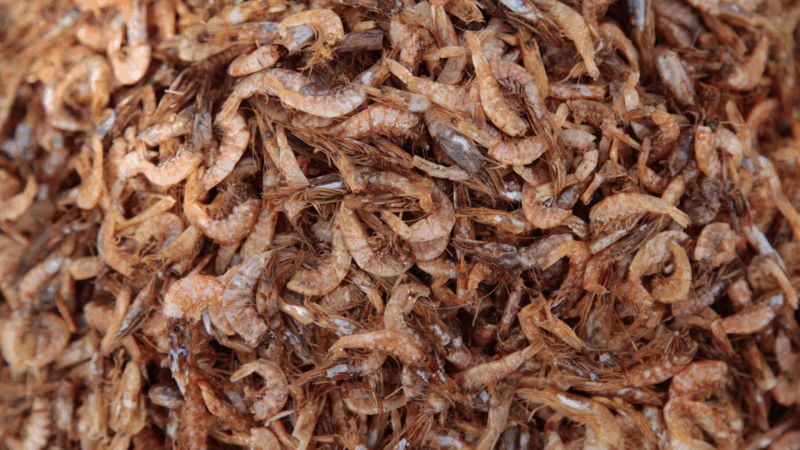Americans are crazy for shrimp. Much of it came from India — until now
VISAKHAPATNAM, India — America’s love affair with shrimp is a cultural touchstone, enough that The Daily Show could air multiple segments out of Red Lobster’s $11 million loss after it offered a $20 endless shrimp buffet in 2023 that proved to be too popular.
In fact, Americans consume more shrimp than any other seafood, about 5.5 pounds per person, per year, and about 40% of it comes from India. Indian shrimp exports to the U.S. totaled more than $2.5 billion in the 2023-24 fiscal year, according to the Indian Ministry of Commerce.
At least, it used to come from India. The industry has been skewered by President Trump’s tariffs applied on many Indian sectors. They were initially set at 25% in August, then doubled, weeks later, to 50%, to punish the Indian government of Prime Minister Narendra Modi for being one of the world’s largest purchasers of Russian oil.
Within India, the eastern state of Andhra Pradesh is particularly exposed, because much of its shrimp — somewhere between 75% to 85% — was exported for the U.S., according to an industry guidebook that used 2023 figures.

Those feeling the impacts include Sita, who returned home after yet another unsuccessful hunt for a new job on a recent August day.
For the past decade, Sita had near-daily shifts in a shrimp processing plant around the corner, in the far-flung suburb of Marikavalasa. But she says her supervisor told her in July to wait for his call: “We haven’t heard from him since,” Sita said.
Sita is a single mother to two teenage boys. She told NPR that she paused her sons’ education for now, because she couldn’t afford to pay their private school fees. She worried about making rent, and paying back the $100 loan she took out in August to cover expenses. “If they don’t give us work,” she said, referring to the nearby shrimp processing plant, “how are we meant to survive?”

She was one of about a dozen women who told NPR in Visakhapatnam that they hadn’t had a shift in weeks, or they had their hours curtailed. The women only gave their first names, worried that they’d lose their jobs for good if they were identified.
The industry employs over a million people and involves dozens of export companies, more than 450 shrimp hatcheries, more than 50 feed mills, individual middlemen and about 100,000 shrimp farms, most of them small enterprises. But it is the more than 240 processing plants that offer the bulk of employment. That’s where women like Sita say they stand from morning to evening, handling ice-cold shrimp to prepare it for packaging.
On a recent evening in the village of Bheemunipatnam in Andhra Pradesh, about a dozen women gathered on a neighbor’s porch told NPR that they were paid about $100 a month, the luckiest, around $220, to work in nearby shrimp plants.
One woman, Chinni, described the work as miserable. “Most of us who work at the processing plant face health issues,” she said. “We have swollen feet,” she said. Backaches. Joint pain. But Chinni said a day off was a day without pay — and the shrimp processing plant was the only reliable work in town. So Chinni told NPR the women popped painkillers and continued working.
Their accounts echo reports by rights groups and investigative journalists into India’s shrimp industry, which found widespread underpayment, exploitation of vulnerable migrants and even forced labor. The investigations also found farmers were widely using antibiotics to grow shrimp faster, and in more concentrated numbers.
NPR also met female rice farmers who accused a powerful, politically connected strongman of seizing their land and converting it to shrimp ponds in the Indian state of West Bengal. The women, who spoke to NPR in May 2024, were from the Sandeshkhali district of the Sundarbans, the world’s largest contiguous mangrove forest, an area ideal for shrimp farming.

Now the industry, for better or worse, is dramatically slowing down.
“All the shipments have come to a halt,” said Pawan Kumar Gunturu, the head of the Seafood Exporters Association of India and managing director of Sprint Exports. He said some exporters tried to ship out stock before initial U.S. tariffs kicked in, with uncertainty over who was meant to pay the added fee.
The U.N.’s Food and Agriculture Organization reported a spike in Asian shrimp exports to the U.S. before tariffs rose to 25%. Then in August, the FAO noted that shrimp farmers in India had “reported a drastic drop” in farm sales — by almost 90% — due to a lack of demand from the U.S.
Gunturu said major exporters were keeping shrimp once meant for the U.S. in storage while they looked to increase their market share in other places, perhaps the United Kingdom or other European countries, or elsewhere in Asia like South Korea or Japan. “It might take a little bit of time to diversify markets. Maybe two months, three months, six months, that’s fine,” he said.
But Arjilli Dasu, the general secretary of the Federation of Indian Fisher Organizations, told NPR that most industry players could not wait that long, because their profit margins are so thin. “Farmers, they are getting mostly 5%, traders 5%, exporters also 5% [from sales],” Dasu said.
He said he was already seeing impacts down the line: Traders and exporters were not buying wholesale shrimp from farmers.
That’s why shrimp farmer Rajakrishnan Raju thinks this is his last harvest. “It’s very, very, very bad,” said Raju, 55, as one of his workers shooed away birds that tried to nab some of the premium shrimp raised in ponds just off the coast of Bheemunipatnam.
Raju said he let go of one of his three workers a few weeks ago, saving $220 as he tried to find ways to cut costs. He said shrimp farming had a lot of up-front, fixed costs that he couldn’t reduce: the purchase of fry, or hatchlings, their feed, power to aerate the ponds and pump in fresh sea water.

Raju said his shrimp wouldn’t be ready for market until January, but already Indian traders who buy shrimp wholesale from farmers were offering prices that were lower than his break-even point, because they were pricing in tariffs. His hope now is to sell at the smallest loss possible. “The tariffs will destroy us,” he said.
This may be the fate of all sectors hit by Trump’s tariffs, said Shoumitro Chatterjee, assistant professor of international economics at Johns Hopkins University. “I am kind of very pessimistic on what’s coming.”
Chatterjee said Indian industries could have survived a 25% tariff rate because it wasn’t that much higher than the levies Trump put on imports from competing, neighboring countries: Pakistan at 19%, Bangladesh and Vietnam at 20%.
But “I think surviving the 50% is going to be nearly impossible,” Chatterjee said. “My bigger worry is that the way the tariffs are structured right now, it’s all loaded on sectors that provide jobs,” he said, listing “apparel, footwear, leather, textile, and even food processing.” Those industries offer rare, reliable work in India, even if it is badly paid. Most Indians work on small plots of land.
Some key Indian industries are exempt from tariffs for now, like pharmaceuticals, and smart phones — including iPhones — many of which are exported to the U.S.
India’s Ministry of Commerce did not respond to NPR’s multiple requests for information on how it planned to mitigate the tariffs. Shrimp industry leaders told NPR that the ministry was engaging with them and promising to find them new markets.
Washington and New Delhi are still engaging in trade talks. But Chatterjee said even if Washington and New Delhi came to a deal to lower tariffs, the damage was done.
“Earlier, India was the safe bet,” he said, referring to a push by the previous Biden and Trump administrations for companies to engage Indian companies and to manufacture in India, to boost the country as an economic rival to China.
“So all these opportunities that were coming to India,” he said, “I think all of that is going to dry out.”

America’s top figure skaters dazzled St. Louis. I left with a new love for the sport.
The U.S. Figure Skating National Championships brought the who's who of the sport to St. Louis. St. Louis Public Radio Visuals Editor Brian Munoz left a new fan of the Olympic sport.
DHS restricts congressional visits to ICE facilities in Minneapolis with new policy
A memo from Homeland Security Secretary Kristi Noem, obtained by NPR, instructs her staff that visits should be requested at least seven days in advance.
Historic upset in English soccer’s FA Cup as Macclesfield beat holders Crystal Palace
The result marks the first time in 117 years that a side from outside the major national leagues has eliminated the reigning FA Cup holders.
Venezuela’s exiles in Chile caught between hope and uncertainty
Initial joy among Venezuela's diaspora in Chile has given way to caution, as questions grow over what Maduro's capture means for the country — and for those who fled it.
Sunday Puzzle: Pet theory
NPR's Sacha Pfeiffer plays the puzzle with KAMW listener Daniel Abramson of Albuquerque, N.M, and Weekend Edition Puzzlemaster Will Shortz.
Inside a Gaza medical clinic at risk of shutting down after an Israeli ban
A recent Israeli decision to bar Doctors Without Borders and other aid groups means international staff and aid can no longer enter Gaza or the West Bank. Local staff must rely on dwindling supplies and no international expertise.








